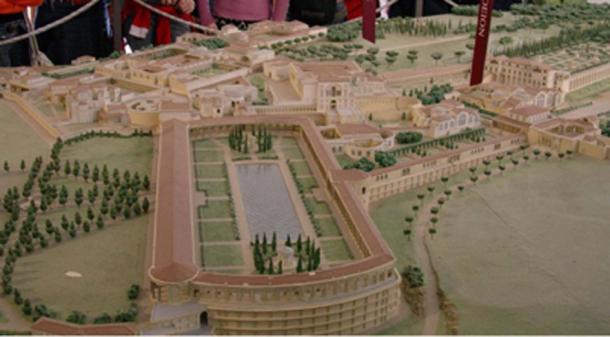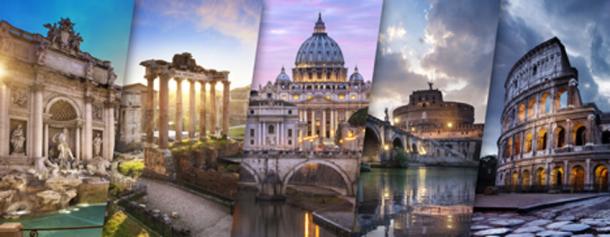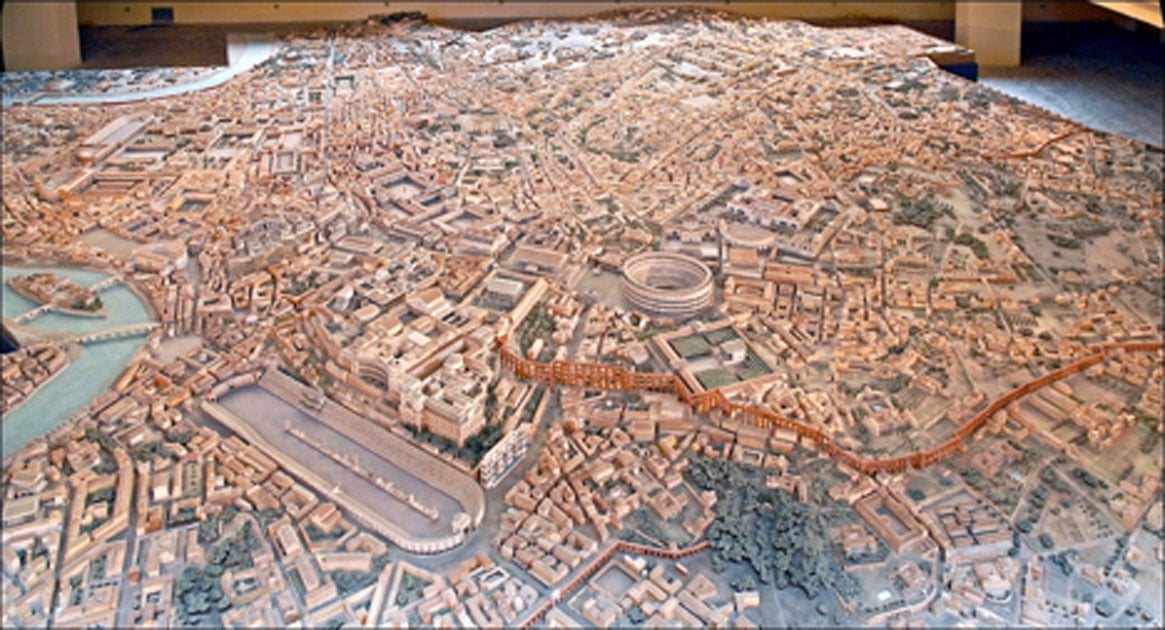The Plastico di Roma Imperiale Wasn’t Built in a Day: Accurate Mini Rome Model Took 35 Years
The Roman Empire dominated most of Europe and parts of Africa and the Middle East for over thousand years, evolving from a monarchy to a democracy and finally a militaristic dictatorship. The empire grew out of a small settlement on the Italian Peninsula, to one of the largest empires in recorded history with up to 90 million inhabitants – 20% of the world population at that time – at its height.
The scope of the empire was in no small part due to the efficiency and ruthlessness of its army, but it did not spread through conquest alone. The Romans also utilized linguistic assimilation, which meant the spread of Latin, so that people from thousands of kilometers apart could communicate with one another. This had a lasting impact across the empire, where many languages today are Latin based with a degree of mutual intelligibility between them in both spoken and written forms.
But another catalyst for the physical spread of the empire is the cultural impact it had. As the empire spread, so did the Roman way of life. Innovations and technology such as underfloor heating and insulated glazing were adopted, as well as the distinctive grid layouts of cities and famously straight Roman roads.
In 1933 an Italian archaeologist named Italo Gismondi was commissioned by Mussolini to create an accurate scale model of the city of Rome. Called the Plastico di Roma imperiale (model of imperial Rome) it became his life’s work. He added to the model until three years before his death at the age of 87, and the project took 35 years to complete.
His training as an architect and dedication to the study of ancient Rome made him an ideal candidate for the project, and he was passionate about creating the most accurate model possible. But what was so special about ancient Rome that it became such a seminal project for one man? And what can a scale model tell us about life in the Roman Empire and the city of Rome itself?
Roman Cities and Architecture
The Romans built hundreds of cities and towns across the empire, and the majority of them followed the same basic plan, which was carefully arranged for the best mix of military defense and convenience for its inhabitants. There was a central forum, which is where the city services were located. This was surrounded by the gridded system of roads, with two diagonal roads which passed though the central square to make traversing the city more efficient.
Wherever possible, they built their cities with a river flowing through them, which provided an effective way to dispose of waste, transportation, as well as a source of water for the citizens. They were surrounded by a wall to aid with defense in the event of a siege.
Roman cities were laid out so efficiently that some Roman built cities, such as Turin, retain this structure even today and this uniformity across the empire meant that cities had the same distinctive Roman buildings, such as amphitheaters and bathhouses.

Model of the Baths of Caracalla, close up from the Plastico di Roma imperiale, in the Museo della Civiltà Romana. (Roger Ulrich / CC BY-SA 2.0)
Their sturdy construction enabled many to survive to date. The town of Plovdiv in modern day Bulgaria is home to the best preserved Roman theater, a special Roman entertainment center called an odeon, a Roman stadium, an aqueduct, and many other ruins from the original Roman construction. The city of Bath, England attracts more than a million visitors each year who come to see the Roman baths, built over the geothermal spring in the city.
There are countless other examples of surviving Roman architecture throughout the empire, not the least within the city itself, which attracts millions of visitors each year to view the grand remains of buildings such as the Pantheon and Trajan’s Market.
Despite their number, and the fact many of them are very well preserved, the buildings stand alone. They may be awe inspiring, but they are lacking in context, and they do not offer a comprehensive insight into life in the empire.
- The Roman Republic – Was It Truly A Republic?
- Five of the Most Powerful and Influential Empires of the Ancient World
- How Ancient Rome Dealt with the Barbarians at the Gate

Model of the Roman Theater, according to the studies of Andrea Palladio. (Magnus Manske / CC BY-SA 3.0)
The Founding of Rome
Rome itself has a fascinating history and most people have heard the legendary foundation story of the great city. It is said that twin brothers named Romulus and Remus, demi-gods who were suckled by a she-wolf, founded Rome on April 21st 753 BC. In a heated argument – sometimes described as over who would rule the city and in other versions over its location – the brothers fought in a bitter battle to the death.
Romulus was the victor, slaying his brother and in turn earning the right to name the city. In a move characteristically hubristic for Roman gods and demi-gods, he chose to name the city for himself, and Rome was born.
A second fable attributes the founding of the city to a Trojan woman named Roma. She traveled with the survivors after the fall of Troy. On a grueling journey to find a new home, the travelers made camp on the banks of the Tiber River.
After a fight between the men who wanted to continue the search and the women who did not, Roma orchestrated the destruction of the Trojan ships. Now stranded, they had no choice but to settle where they were at the site which would become Rome.

Tiber River in Rome. (Vural Yavas / Public Domain)
Other more pragmatic theories are that the city was named for the Roman word for Tiber (Rumon) or that the name came from the Etruscan name for the original trading post.
The Plastico di Roma imperiale is not able to solve mysteries such as how the city got its name, but it is still a valuable resource for historians and archaeologists alike, and it has answered plenty of important questions about life in the city and the remnants which can still be found today.
The EUR and the Museum of Roman Civilization
The Esposizione Universale Roma (EUR) region of Rome is located just south of the city center. It was chosen in the 1930s by Mussolini as the location for the 1942 World’s Fair. The event never took place due to the outbreak of WWII and construction of the district was abandoned when the deadline passed in 1942. The site suffered extensive damage during the war, and for years afterwards it lay uncompleted until fascist era buildings were refurbished or completed for use as modern office blocks and governmental buildings in the 1950s and 60s.
The site was almost completed by the time of the 1960 Olympic Games, which were held in Rome, and today it is home to a number of important cultural buildings such as the Central Archives, National Museum of the Middle Ages, the Prehistoric Ethnographic Museum, and the Planetarium and Astronomical Museum.
It is also where the Museo della Civiltà Romana (Museum of Roman Civilization), which houses the sprawling scale model of the ancient city, is located. The museum is devoted to all aspects of ancient Roman civilization and covers the origin of the city through to the 4th Century. There are scale models (as well as Gismondi’s model of imperial Rome there are considerably more modest models of the archaic city), reproductions, and original artwork and artifacts.

Model of Museo della Civiltà Romana. (Magnus Manske / CC BY-SA 2.0)
Even without the Plastico di Roma imperiale, the museum is impressive in its scope and the exhibits it displays. There is a reconstructed Roman library based on the one in the Villa Adriana, and a sequence of reliefs from Trajan’s Column (a triumphal column detailing the victory of Trajan in the Dacian Wars) which have been arranged at ground level, so they can be easily read.
- Roman Mythology of the Ages of Man, Metamorphoses and the Founding of Rome
- Ancient Journeys: What was Travel Like for the Romans?
- Eating Like a Roman: Healthy Greens, Gritty Bread and Fish Paste – The Evolution of Ancient Roman Cuisine

Model in the Villa Adriana. (Magnus Manske / CC BY-SA 1.0)
The museum is split into three sections. A historical section, a thematic section, and the Plastico di Roma imperiale. The historical section covers ancient Rome in chronological order, splitting it into eleven periods. There are a number of scale models in this section, including a reconstruction of the Theatre of Marcellus at 1:100 scale and the model of archaic Rome. The thematic section covers all aspects of life in ancient Rome. From agriculture to the arts and medicinal practices.
Gismondi’s Sources for the Plastico di Roma imperiale
Gismondi’s model of imperial Rome stands alone. It is an impressive 1:250 scale, and it depicts Rome at the time of emperor Constantine I, during the 4th Century AD. The model was installed in the Museum of Roman Civilization in the 1950s, but Gismondi added to it until 1971.
Made from plaster, the model is based on the Forma Urbis Romanae – a map by a renowned Italian archaeologist and topographer named Rodolfo Lanciani. Lanciani was an extremely talented archaeologist and a pioneer in the field of Roman topography. Although he completed a number of successful excavations, the Forma Urbis Romanae is considered his greatest work.

Forma Urbis Romanae by Rodolfo Lanciani, which the Plastico di Roma imperiale was modeled after. (Ωméga * / CC BY-SA 2.0)
It is a series of 46 maps, detailing ancient Rome in extraordinary detail. They were released between 1893 and 1901 and they are still widely respected today, even though there have been a lot of new discoveries since they were drawn. The maps show ancient Rome in black with the plans of the modern city marked in red for reference.
Gismondi’s model is now regarded by many as the most important source for how ancient Rome looked. Landmark buildings like the Colosseum were modeled on precise maps and plans. Areas of residential housing or those which had no archaeological reference from Rome were modeled on other examples of ancient construction. Some of the gaps in physical evidence were because of Mussolini – even though it was him who commissioned the model, many ancient Roman houses were destroyed on his orders leaving Gismondi with no surviving examples for his model.
Use of the Model
The model was initially commissioned as a piece of propaganda. Mussolini had intended the model be displayed at an event commemorating the 2000th anniversary of the death of Augustus. It was a way of cementing the links between his fascist regime and imperial Rome. It was also a tool for legitimizing the brutal overhaul of the city and large scale construction projects Mussolini was demanding.
But it has proven to be much more than a piece of fascist propaganda. It has allowed generations of school children and tourists to picture the city as it once was – seeing the remaining monuments, such as the Colosseum, in their original context helps people envision the streets people once walked and the setting such grand buildings fit into. The locations and numbers of buildings help show what was important to people living in ancient Rome.
The huge size and immaculate detail of the model has also been useful for people who aim to bring Rome to life on the big screen. Filmmaker Ridley Scott used shots of Gismondi’s model in the film Gladiator, showing Rome as it once was with a level of accuracy which would not have been possible without it.
The model is also used by archaeologists and historians. When new excavations take place, the model helps to visualize what they are working on and the things they might expect to find during a dig. It helps to identify objects which may otherwise defy explanation or seem out of place, and thanks to the uniformity of Roman city building it is more than a guide to Rome itself, but useful in anticipating where things may be found in other cities built using the same guidelines.

The model, Plastico di Roma imperiale, helps archaeologists and historians visualize ancient Rome. (PUNTOSTUDIOFOTO Lda / Adobe Stock)
Just as casual visitors to the model may get a sense of what Romans saw as important, the buildings which are central in Rome and in the cities built throughout the empire, it makes it easier for historians to see what was central to Roman culture and the way the people of the Roman empire lived.
Thirty-five years is a long time and working on a model may seem like a frivolous thing to dedicate an entire career to. But the work that Gismondi did should not be dismissed. The model was tirelessly researched and meticulously constructed. It has allowed huge numbers of people to connect with and better understand a culture from thousands of years ago and it remains an important resource for scholars and tourists alike even with the onset of more interactive tools like VR and computer modeling.
Top image: Plastico di Roma imperiale at the Museum of the Roman Civilization. Source: Jean-Pierre Dalbéra / CC BY-SA 2.0.
References
Adkins, L. 1998. Handbook to Life in Ancient Rome. Oxford University Press.
Allen, M. 2005. The Roman Baths of Bath. [Online] Available at: https://www.timetravel-britain.com/articles/stones/romanbaths.shtml
Casson, L. 1998. Everyday Life in Ancient Rome. The John Hopkins University Press.
Gilson, P. 2008. Rituals of a Nations Identity: Archaeology and Genealogy in Antiquities Museums of Rome. ProQuest.
Mark, J. 2009. Ancient Rome. [Online] Available at: https://www.ancient.eu/Rome/
Petit, P., Hornblower, S., MacMullen, R., Badian, E., Thomson do Grommond, N., and Ferguson, J. 2019. Ancient Rome. [Online] Available at: https://www.britannica.com/place/ancient-Rome
Roman Plovdiv. Date Unknown. The City. [Online] Available at: http://www.romanplovdiv.org/en/city
Stewart, J. 2018. Archaeologist Spends Over 35 Years Building Enormous Scale Model of Ancient Rome. [Online] Available at: https://mymodernmet.com/scale-model-ancient-rome/
Treccani. Date Unknown. Lanciani, Rodolfo. [Online] Available at: http://www.treccani.it/enciclopedia/rodolfo-lanciani/



















